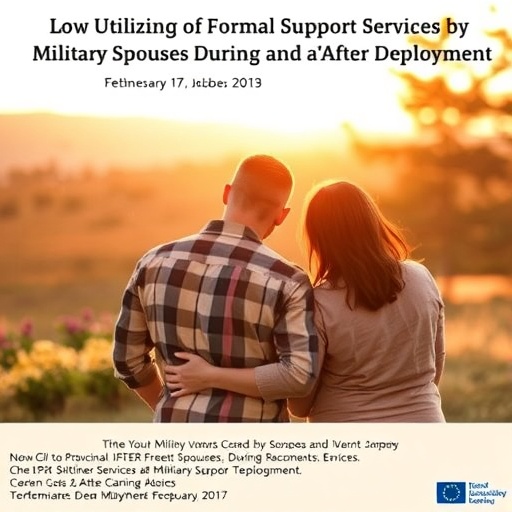Military spouses face an often-overlooked yet profoundly challenging reality as they navigate the emotional and practical turbulence caused by cycles of deployment and reintegration. These periods frequently usher in stress, disrupt family stability, and demand complex adjustments that can strain even the most resilient households. Despite formal resources provided by the Department of Defense designed to alleviate these pressures, recent research reveals that military spouses rarely utilize these official programs. A groundbreaking study led by communication expert Leanne Knobloch from the University of Illinois Urbana-Champaign sheds critical light on this disconnect, offering new perspectives on the types and efficacy of support military spouses actually receive.
The investigation meticulously analyzed survey responses from 1,325 military spouses whose partners had returned from deployment within the previous six months. This robust dataset, drawn from the Millennium Cohort Family Study—a comprehensive, longitudinal project tracing military family dynamics—allowed researchers to peer beneath conventional assumptions about social support. Instead of focusing on perceived availability of help, Knobloch’s team delved into the actual, utilized support mechanisms and how these interactions influenced mental health, social functioning, and marital quality during the reintegration phase.
One startling discovery from the study was the striking underutilization of formal support services. Only 16.5% of military spouses reported participating in formal reintegration programs, such as those facilitated by chaplains, healthcare practitioners, or community support groups. Even broader formal social services were accessed by just over a fifth of respondents. These figures suggest a systemic gap between availability and actual engagement with institutional resources, raising critical questions about awareness, accessibility, and perceived utility.
In contrast, the vast majority of military spouses—52%—relied heavily on informal support networks, primarily comprising family members, friends, neighbors, and coworkers. This reliance on personal social circles underscores the vital but frequently underestimated role of informal emotional and tangible support during highly stressful transitional periods. Knobloch emphasizes that these intimate connections, often overlooked in policy discussions, are essential in fostering better mental health outcomes and higher marital satisfaction upon reintegration.
Digging deeper, the data revealed that the quality of informal support directly correlated with positive outcomes. Military spouses who leaned on friends and family during their partners’ deployments showed significantly improved mental health, social integration, and marital relationships compared to those who did not. This finding highlights the undeniable strength of interpersonal human connections amid the challenges posed by military life and suggests that informal networks are not merely a stopgap but may provide a fundamental buffer against reintegration stressors.
However, the study also pinpointed considerable barriers impeding greater use of formal support programs. Nearly half of the respondents unaware of existing reintegration resources identified lack of awareness as a primary reason for their nonparticipation. Meanwhile, 40% reported no programs were available in their area. Additional deterrents included logistical challenges such as limited childcare, scheduling conflicts, and skepticism regarding program usefulness—especially among women and those military spouses who themselves served in the armed forces.
These barriers indicate that generic, one-size-fits-all approaches in formal reintegration support may fall short of meeting the diverse and nuanced needs of military spouses. For example, childcare was specifically problematic for parents with multiple children and those affiliated with the Air Force or Marine Corps—a nuance that calls for tailored program adaptations. Moreover, questions about relevance and efficacy of training point to a need for enhanced communication and transparency concerning program benefits.
Interestingly, the study found that employment outside the home or a partner’s combat experience increased the likelihood of formal program engagement. Yet, notable underserved populations persisted, including spouses of enlisted personnel, unemployed spouses, and Hispanic military family members. This uneven participation raises issues of equity in accessing critical support, potentially exacerbating vulnerabilities within these demographics.
The implications of these findings extend beyond immediate family well-being. Military leadership and policymakers grapple with retention challenges, and unmet support needs among spouses correlate with higher attrition rates among service members. The study advocates for elevating support programs to a command-level priority to enhance family resilience and retention, urging policymakers to harness the evidence supporting the impact of informal support while simultaneously expanding accessible and targeted formal interventions.
Knobloch and colleagues further emphasize the value of community engagement strategies aimed at educating civilians about military life transitions and creating inclusive support ecosystems. Such grassroots involvement could offer supplementary emotional and practical resources, complementing formal channels and reinforcing the social fabric that military spouses so heavily depend upon.
Technology also presents promising avenues. Virtual, on-demand training programs could overcome logistical barriers like time constraints and childcare by offering flexible access to reintegration resources. Furthermore, promotional efforts that highlight success stories and empirically validated benefits might counteract skepticism, encouraging more spouses to seek and accept formal help.
This comprehensive study, situated within the expansive Millennium Cohort Program funded by agencies including the Defense Health Agency and the Department of Veterans Affairs, marks a pivotal contribution to military family research. By balancing analytical rigor with empathetic insight, it illuminates the complex tapestry of support systems that underpin military spouses’ resilience and underscores the urgent need for multifaceted, culturally aware, and accessible support frameworks.
As military families continue to navigate the unpredictable landscape of deployment cycles, this research encourages a paradigm shift—one that embraces informal networks as crucial lifelines and recognizes the limitations of current formal programs. Bridging this gap is not just a matter of policy but a societal imperative, demanding innovative, inclusive strategies that honor the profound sacrifices military spouses endure.
Subject of Research: People
Article Title: Availability, predictors, and outcomes of actual support for military spouses during deployment and reunion: Findings from the Millennium Cohort Family Study
News Publication Date: 29-Jul-2025
Web References:
- University of Illinois, Leanne Knobloch Profile
- Naval Health Research Center
- Millennium Cohort Family Study
References:
Knobloch, L., McMaster, H. S., Tannenbaum, K., & Ray, T. N. (2025). Availability, predictors, and outcomes of actual support for military spouses during deployment and reunion: Findings from the Millennium Cohort Family Study. Military Psychology. DOI: 10.1080/08995605.2025.2485711
Image Credits: Photo by L. Brian Stauffer
Keywords: Family, Marriage




